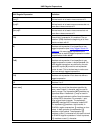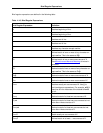
SlickEdit Regular Expression Definition
avoid ambiguous expressions. For example a:9()1
searches for nine instance of the letter a followed
by a 1.
X:n1, Maximal match of at least n1 occurrences of X.
X:n1,n2 Maximal match of at least n1 occurrences but not
more than n2 occurrences of X.
X:*n1, Minimal match of at least n1 occurrences of X.
X:*n1,n2 Minimal match of at least n1 occurrences but not
more than n2 occurrences of X.
~X Search fails if expression X is matched. The ex-
pression ^~(if) matches the beginning of all lines
that do not start with if.
(X) Matches sub-expression X.
{X} Matches sub-expression X and specifies a new
tagged expression. See Using Tagged Search Ex-
pressions for more information.
{#dX} Matches sub-expression X and specifies to use
tagged expression number d where 0<=d<=9.
X|Y Matches X or Y.
[char-set] Matches any one of the characters specified by
char-set. A dash (-) character may be used to
specify ranges. The expression [A-Z] matches any
uppercase letter. Backslash (\) may be used inside
the square brackets to define literal characters or
define ASCII characters. For example, \- specifies a
literal dash character. The expression [\0-\27]
matches ASCII character codes 0..27. The expres-
sion [] matches no characters. In UNIX regular ex-
pressions, []] matches a right bracket. In both syn-
taxes, the expression [\]] matches a right bracket.
The expression [\^] matches a caret (^) character in
both syntaxes.
[~char-set] Matches any character not specified by char-set.
A dash (-) character may be used to specify ranges.
The expression [~A-Z] matches all characters ex-
SlickEdit® Regular Expressions
527


















